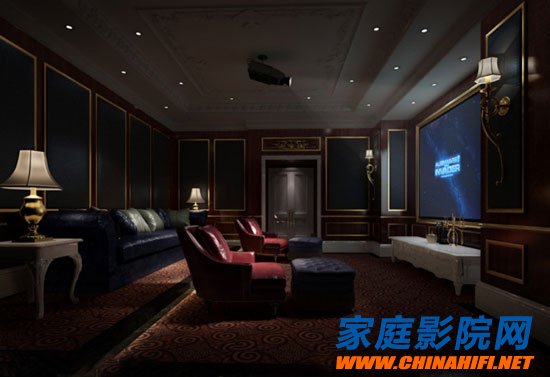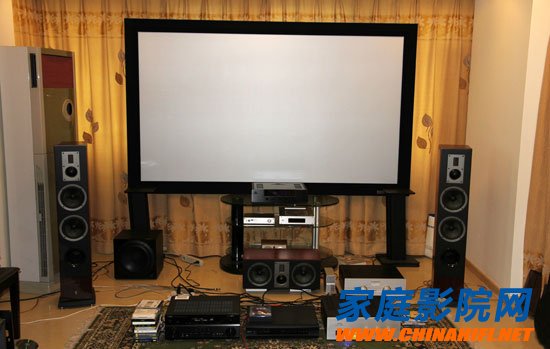How to arrange audio to build a professional home theater
First of all, attention should be paid to the acoustic characteristics of the indoor space to ensure that the acoustic performance of the left and right sides of the speaker is symmetrical, and the sound absorption and reflection characteristics of the left and right sides are consistent. For example, on both sides of a room is a wall, we can place the sound in a bilaterally symmetrical position, but this does not guarantee the consistency of its acoustic characteristics. For example, if one side of the room is a brick wall and one side is a glass window, if the window is closed, the acoustic performance of the two sides is similar; but if one side of the window is opened, the acoustic characteristics of the two sides are asymmetrical, and the window is opened. One side will have a lost voice.
Similarly, if one side of the room is a brick wall and one side is a wooden wall, the acoustic characteristics are asymmetrical, and there will be a loss of sound on the side of the window. Similarly, if one side of the room is a brick wall and one side is a wooden wall, the sound absorption characteristics of the wooden wall are stronger, and the effect is similar when opening the window. At this time, the sound absorption coefficient of one side of the brick wall should be increased, and the sound absorbing material can be laid on the brick wall to balance the acoustic characteristics of the two sides as much as possible.

The main speaker plays the main music and the picture effect sound signal, which is used to highlight the main atmosphere of the picture and the background sound effect of the scene. The left and right speakers with the same characteristics such as rated power, frequency response bandwidth and smoothness should be selected. Keep the acoustic characteristics consistent when placed, so that the left and right main channels are well balanced and matched.
The center speaker is used to transmit the dialogue of the character. Its rated power, bandwidth response bandwidth, smoothness and other characteristics should be consistent with the main speaker, and its rated power can be slightly smaller than the main speaker. The center speaker can be placed above or below the TV. Because it is close to the TV, the center speaker must be anti-magnetic, otherwise the picture tube will be magnetized. The front speakers should remain in line with the center speaker, or before it, never place the front speakers behind the center speakers.

The surround sound box provides an ambient sound to create a uniformly diffused closed surround sound field with a narrow band around the speaker and a lower power rating than the main speakers. Depending on the conditions of the indoor space, the surround sound box can be placed in a variety of ways, such as being placed in front of the listener, behind the side, slightly above the head of the listener, and the two surround sound boxes must be placed symmetrically. The common method is that both speakers are facing the listener, or both speakers are facing the wall, passing through the reflection of the wall to the listener, or both speakers are facing the ceiling, and the reflection from the ceiling is transmitted to the listener. .
Subwoofers are used to create powerful bass effects for unique sound effects such as dull cannons, explosions, and more. A subwoofer can usually be placed between the front left and center speakers.
A rice cooker or rice steamer is an automated kitchen appliance designed to boil or steam rice. It consists of a heat source, a cooking bowl, and a thermostat. The thermostat measures the temperature of the cooking bowl and controls the heat. Complex rice cookers may have many more sensors and other components, and may be multipurpose. Cooking rice has traditionally required constant attention to ensure the rice was cooked properly, and not burnt. Electric rice cookers automate the process by mechanically or electronically controlling heat and timing, thus freeing up a heating element on the cooking range that had to be otherwise occupied for rice cooking. Although the rice cooker does not necessarily speed up the cooking process, with an electric rice cooker the cook's involvement in cooking rice is reduced to simply measuring the rice, preparing the rice properly and using the correct amount of water. Once the rice cooker is set to cook, the rice will be cooked with no further attention.
Features:
For modern home rice cookers, the smallest single-person model cooks 1 rice cup (180 ml), whereas large models can cook 10 cups. Commercial models can cook 20 or more cups. As a possible source of confusion, model specifications and names may list either cooked or uncooked capacity. Rice roughly doubles in size during cooking; therefore, a 10 cup (uncooked) rice cooker can produce up to 20 cups of cooked rice. The prices vary greatly, depending on the capacity, features, materials used, and the country of origin.
The majority of modern electric rice cookers are equipped with a stay-warm or keep-warm feature, which keeps the rice at an optimal temperature for serving without over-cooking it. Some gas cookers also have electric stay-warm mechanism. However, the usefulness of this feature degrades over time, a microwave may be more energy efficient or better suited to reheat rice that will sit longer than four hours.
Some rice cookers use induction heating, with one or more induction heaters directly warming the pot. This can improve energy efficiency.
Most modern rice cookers use aluminium for the inner cooking bowl. There are some models that use stainless steel instead of aluminium. Various other materials, such as copper, pure carbon, ceramic, and diamond powder coating, may be used for higher heat conductivity or better taste.
The pressure-cooking models can raise the water's boiling point higher, e.g., from 100 °C at 1.0 atm up to about 110 °C at 1.4 atm, which speeds cooking. The pressure-cooking models can also be used in high altitude areas, where the boiling temperature is below 100 Celsius. Pressure cookers are also suitable for cooking brown rice (which contains oils and bran fiber that cook differently from pure white rice starch). Some pressure rice cookers have a varying pressure control mechanism (named the "dual-pressure" method) that creates repeated pressure/release cycles during the cooking.
There also exist mechanisms to collect and return the boiled over liquid to the inner rice bowl.
Many cookers now have microprocessor-controlled cooking cycles, which are often used to adjust for rice and cooking type.
Applications
Rice cookers are typically used for the preparation of plain or lightly seasoned rice. Each rice cooker model may be optimized to cook a certain type of rice best. For example, most Japanese rice cookers are optimized for cooking Japanese rice and may not be the best for other types of rice[citation needed], although cooking time can be lengthened simply by more water.
The typical method of cooking long grain rice is boil-and-strain and/or steaming method. The absorption method used in Japanese rice cookers will produce slightly different texture and taste, usually stickier rice.
Brown rice generally needs longer cooking times than white rice, unless it is broken or flourblasted (which perforates the bran).
Different varieties of rice need different cooking times, depending on their grain size, grain shape, and grain composition. There are three main types of Asian rice: Oryza sativa subsp. indica, i.e., Indian rice (long grain rice, e.g., basmati rice and Thai jasmine rice), O. sativa subsp. javanica, i.e., Java rice (large grain rice) and O. sativa subsp. japonica, i.e., Japanese rice (medium grain rice, e.g., Calrose rice, short grain rice, e.g., most Japanese rice and risotto rice).
African rice, Oryza glaberrima, is an entirely separate species, but can be cooked in the same way. Zizania is not even in the same genus, although it is often called a rice (or "water oats"); it, too, can also be cooked in a rice cooker.
A rice cooker can be used to cook many boiled or steamed granular foods, such as pot barley, bulgar wheat, and dal. Provided the ingredients have similar cooking times, a rice cooker can cook mixtures such as khichdi. Some rice cookers can be used as automated couscoussiers, cooking couscous and a stew simultaneously.
Rice Cooker
Rice Cooker,Drum Rice Cooker,Deluxe Rice Cooker,Straight Rice Cooker
Guangzhou Taipeng Electrical Appliances Technology CO., LTD. , https://www.kettles.pl
